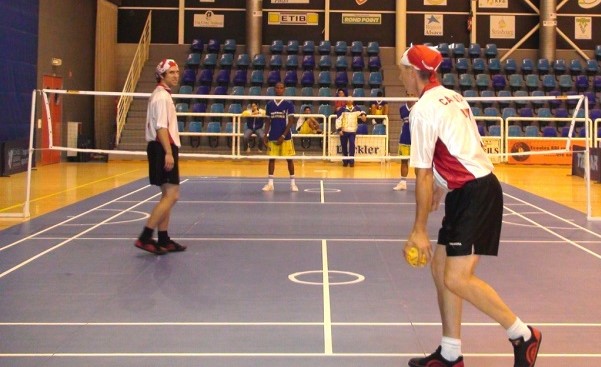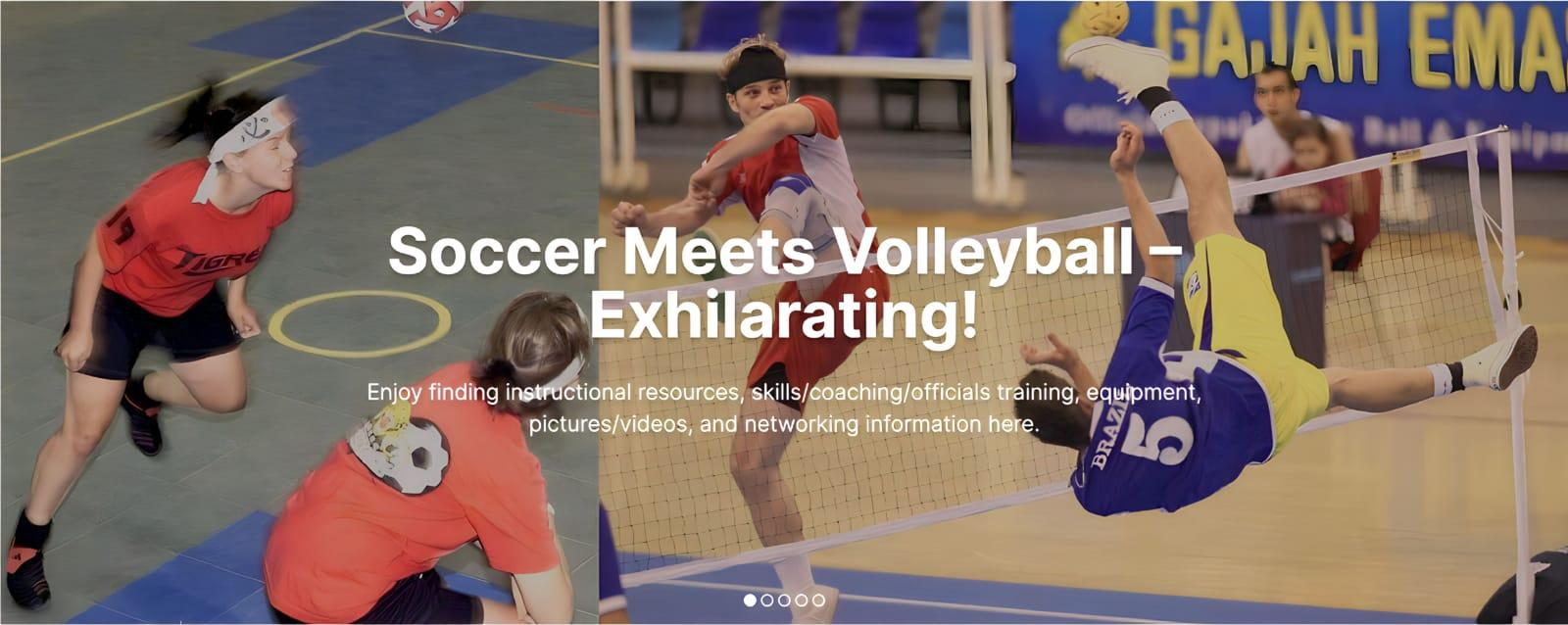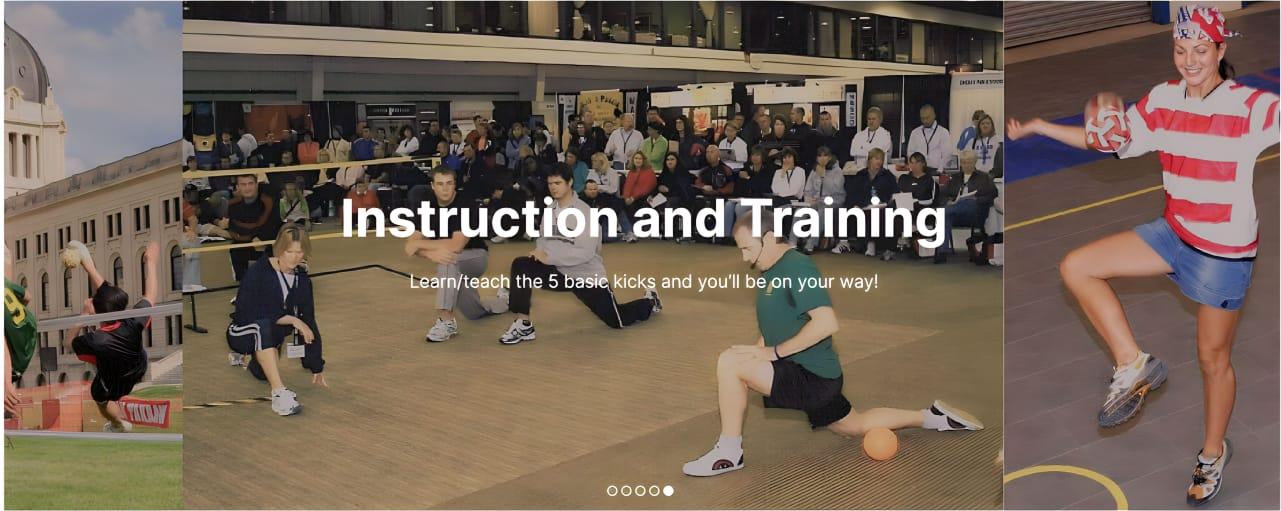"Doubles" Sepak Takraw

Official International Rules for "Doubles" Sepak Takraw (Playing 2 on 2)
Current rules* with amendments approved by ISTAF in Bangkok, Thailand, Jan. 16-17, 2011
*Re-written to be clearer, using consistent terminology and more grammatically correct than original version
1. THE COURT
1.1. The Court – The court is an area of 13.4 meters (m) X 6.1 m, or 44 feet (ft.) X 20 feet ft., free from all obstacles up to the height of 8 m, or 26.25 ft., measured from the floor surface, and free of all obstacles on the floor or ground up to a distance of at least 3.0 m, or about 10 ft., from the edges of the court all the way around.
1.2. Sidelines & Baselines – The width of the sidelines (two sides) and baselines (two back ends) bounding the court should not be more than 0.04 m, or 1 ½ inches (in.), measured and drawn inward from the outer edge of the court measurements.
1.3. The Center Line – A Center Line of 0.02 m, or ¾ in., should be drawn across the centre of the court, from side to side, to divide the court into two equal halves.
2. THE POSTS
2.1. The posts shall be 1.55 m, or 5 ft. 1 in., in height from the floor for both men and women and shall be made of strong materials and of sufficient firmness to be able to maintain high net tension.
2.2. Position of Posts – The posts shall be erected or placed firmly 0.3 m, or 1 ft., outside the sideline boundary and directly in line with the center line.
3. THE NET
3.1. The net shall be made of fine ordinary cord or nylon with 0.06 m to 0.08 m, or 2 ½ to 3-inch, mesh.
3.2. The net shall be 0.7m, or 2 ft. 4 in., in height (top to bottom) and not shorter than 6.1 m, or 20 ft., in width (side to side).
3.3. The net shall be edged on both sides along the sideline edges from top to bottom with 0.05 m, or 2-inch, tape, and shall be called Boundary Tape.
3.4. The net shall also be edged with at least 0.05 m, or 2-inch, tape on both sides along the top and bottom, and shall be supported by a fine ordinary cord or nylon cord that runs through the tape and is tightened at the posts.
3.5. The top of the net shall be 1.52 m, or 5 ft., in height from the floor at center court for men and 1.42 m or 4.65 ft. for women, while the height at the posts shall be 1.55 m or 5 ft. 1 in. for men, and 1.45 m or 4.75 in. for women.
4. THE SEPAK TAKRAW BALL
4.1. The Sepak Takraw ball shall be spherical, made up of one woven layer of synthetic fiber, or any other ISTAF approved materials, having 12 holes and 20 intersections.
4.2. For men, the ball circumference shall not be less than 41 cm, or 16.14 in., and not more than 43 cm, or 16.93 in. For women, the ball circumference shall not be less than 42 cm, or 16.54 in., and not more than 44 cm, or 17.32 in.
4.3. For men, the weight of the ball before play shall not be less than 170 g, or 6 oz., and not more than 180 g, or 6.35 oz. For women, the ball weight before play shall not be less than 150 g, or 5.3 oz., and not more than 160 g, or 5.6 oz.
4.4. The ball can be a plain singular , multi-ed, or made of luminous s, but not of any that will impair the performance of the players.
4.5. All world, international, or regional competitions sanctioned by ISTAF, including but not limited to, the Olympic Games, World Games, Commonwealth Games, Asian Games, and South East Asian Games must be played with ISTAF approved balls – provided there is a fair, unbiased and transparent approval process.
5. THE PLAYERS
5.1. A Doubles Match is played by two “Regus”, each consisting of two players.
5.2. One of the two players shall be at the back of the court, positioned behind the baseline for the service kick, and is called a “Tekong” (Server). The Tekong also acts as his/her own thrower, tossing the ball up to them self for the service kick, from any position along and behind the baseline.
5.3. The other non-serving player of the Serving Regu is known as "Alternate Tekong", and he/she, along with the players of the Receiving Regu, can be positioned anywhere within their respective courts during the serve.
5.4. Doubles - Regu Event
5.4.1. Each “Regu” shall consist of a minimum of 2 players and a maximum of 3 players (which is 1 “Regu” of 2 players plus 1 “Reserve Player” that may be substituted in if necessary), all of whom must be registered prior to a Doubles Regu Event Match.
5.4.2. Prior to the commencement of a Doubles Regu Event “Match”, each “Regu” must have a minimum of 2 registered players present on the playing court.
5.4.3. Any “Regu” having less than 2 players will not be allowed to play the “Match” and will be considered as having lost the “Match” in three straight “Sets”, with each set’s score being 0-21.
5.5. Doubles - Team Event
5.5.1. Each “Team” shall consist of a minimum of 6 players (3 “Regus” of 2 players per “Regu”) and a maximum of 9 players, which allows for 1 “Reserve Player” per “Regu” to be included.
5.5.2. Prior to the commencement of a Team Event “Game”, each “Team” must have a minimum of 6 registered players present on the playing court.
5.5.3. Any “Team” having less than 6 players will not be allowed to play the “Game” and will be considered as having lost in 2 (or 3, as applicable) straight matches, and each match being recorded as lost in two straight sets with each set’s score being recorded as 0-21.
6. PLAYER’S ATTIRE
6.1. All equipment used by players must be appropriate for Sepak Takraw. Safety and fairness are the priorities. Any equipment that increases or reduces the speed of the ball or increases the height of the player so as to give an unfair advantage and/or endanger the safety of himself/herself or other players shall not be allowed.
6.2. To avoid unnecessary conflicts or confusion, two opposing “Regus” or “Teams” must wear different jerseys.
6.3. Regus/Teams must have a minimum of two sets of Jerseys/T-shirts, one light and the other dark in . If both Regus/Teams arrive at a match/game dressed in jerseys of the same , the home Regu/Team must change. On a neutral site, the Regu/Team listed first on the match/game program shall change.
6.4. A player’s attire shall consist of jerseys/T-shirts, shorts, socks and sports shoes with rubber souls without heels. The entire apparel of a player is regarded as part of his/her body, so to avoid “Net Fouls”, if jerseys or T-shirts are baggy or loose, and not snug-fitting, it is RECOMMENDED that they be tucked into the shorts. In case of cold weather, players are permitted to wear tracksuits. Optional attire may also include a cloth head band or bandana and ankle, knee and/or wrist tensor supports.
6.5. All jerseys/T-shirts shall be numbered on both the front and back. A player must be assigned only one (1) permanent number, from 1 to 36 only, to be used throughout a tournament. The size of the numbers shall be not less than 19 cm, or 7 ½ inches, in height on the back, and not less than 10 cm, or 4 inches, in height on the front (top-center or sides chest area).
6.6. For International Competitions, players’ names must be placed on the back of the playing shirt above the number, and be of sufficient size to be visible on television. Playing shirts may also carry a sponsor logo on the front of the playing shirt, subject always to the applicable tournament regulations. No other commercial identification (other than a manufacturer logo) may appear on any player attire.
6.7. The Captain of each Regu shall wear an armband of a different from the Jersey/T-shirt on the left arm.
6.8. Any other apparel not specifically mentioned in these rules must first receive approval of the ISTAF Technical Commission before use.
7. SUBSTITUTION
7.1. Substitution of a player is allowed at any time on request made by the Team Manager or Coach to the Court Referee when the ball is not in play.The substitution card shall indicate the jersey number of the outgoing player.
7.2. Each Regumay nominate none to maximum of ONE reserve player, AND MAYMAKE UP TO TWO SUBSTITUTIONS PER SET for both Regu and Team events. A player who had been substituted out earlier shall be allowed to re-enter the court in a second substitution in the same set.
7.3. Each Regu will be allowed to make a substitution for an injured player on the court provided their TWO substitutions have NOT been made earlier in the set. If BOTH substitutions had already been made, the Regu will not be allowed to continue and will be considered as having lost the match with the injured Regu’s last recorded points being their final score, while the winning Regu automatically scores 21 points, or whatever the winning score would have been if they were “Playing to 25”.
7.4. If, after a Doubles Regu has already made two substitutions, one of the 2 players on the court gets sent off by the Referee with a “Red Card”, that Regu will NOT be allowed to continue the match with only one player left on the court and will be considered as having lost the match, with their last recorded points being their final score, while the winning Regu automatically scores 21 points, or whatever the winning score would have been if they were “Playing to 25”.
8. ON COURT SEPAK TAKRAW OFFICIALS
8.1. ONE Court Referee, who sits at a table behind the Match Referee, watches the match closely in a general sense and looks out for anything out of the ordinary (i.e., a player faking an injury or an unnecessary apparel adjustment, just to create a bit of a rest for the team, etc.), while ensuring that all the rules of the game are followed by all. The Court Referee has the final word on any dispute during a match. He/she should be very experienced with all aspects of the game, but especially with refereeing, and should be formally dressed to project the importance and professionalism that comes with the job/title.
8.2. ONE Match Referee, who sits on a high chair beside the pole overlooking the net (eye level being about 2 feet above net), a couple feet out from side, is the person who basically controls the flow of the game. He/she: calls the captains forward for the coin toss; times and controls the warm-ups, time outs, and between set rests; announces what the match is and introduces each Regu to the audience prior to commencement of play; marks the score play by play on an official score sheet; calls the score just before each service toss; watches for and calls faults; announces the winner and the final score at the end. He/she should be very experienced with all aspects of the game, but especially with refereeing, and should be formally dressed to project the importance and professionalism that comes with the job/title.
8.3. ONE Assistant Match Referee, whoSTANDSbehind the post a couple feet out from sideline on the opposite side of the court/net from the Match Referee, mainly assists the Match Referee in watching for and calling faults and out of bounds balls. The critical area to watch closely is the action over the net. He/she also keeps extra Takraw balls beside him/her to quickly give to players if the game ball goes way out of bounds. He/she should be very experienced with all aspects of the game, but especially with refereeing, and should be formally dressed to project the importance and professionalism that comes with the job/title.
8.4. TWO Lines Judges, whoSTANDat opposite and adjacent corners of the court from each other (at least 10 feet out from the corner of court) watching mainly the end zone, but also the sideline closest to them, for whether or not balls land in or out of bounds. They stand so that if need be they can quickly move out of the way of oncoming balls and not interfere with a player who is attempting to bring the ball back into play. The Lines Judges’ decisions could very well dictate the outcome of a match, therefore they need to know the game, be mature, professional, alert, be completely focused on the ball’s movement with every rally, and preferably (but not mandatory) also have Refereeing training/experience. The Lines Judges should also be formally dressed to project the importance and professionalism that comes with the job/title.
9. THE COIN TOSS AND WARM-UP
9.1. Immediately before the start of a match, the Court Referee will conduct a coin toss in the presence of the opposing captains. The winner of the coin toss may elect to either (a) serve or receive, or (b) choose which side of the court to start the match from. The loser makes the remaining choice.
9.2. The side that loses the coin-toss will abide with the Court Referee’s instructions.
9.3. The Regu being awarded with the “service” shall “warm-up” first for 2 minutes followed by the other Regu. Only 3 persons are allowed to move freely on the court during the warm up.
10. POSITION OF PLAYERS DURING SERVICE
10.1. At the start of play, the players of both Regus must be in their respective courts in a ready position.
10.2. The “Tekong” (or Server) of the Serving Regu shall be positioned behind the baseline for the service kick, and also acts as his/her own thrower, tossing the ball up to them self for the service kick, from any position along and behind the baseline.
10.3. The non-serving player for the Serving Regu, can position himself/herself at any location within his/her side of the court, but must stay in one spot while the serve is being made.
10.4. The opponent or Receiving Regu is free to be anywhere within their court.
11. THE START OF PLAY AND SERVICE
11.1. The Regu that serves first (according to the toss decision) shall start the first set and serve for the first three (3) points, followed by the other side serving for three (3) consecutive points. Both sides alternate serving in this way after every three (3) points, regardless of which side wins a point.
11.2. When the score is tied 20-20, or deuce, the serve shall alternate between opposing sides on every point.
11.3. The side which “receives” last in any set shall serve first in any subsequent set.
11.4. Players shall switch ends before the start of each set – except for prior to a “Tiebreak Set”, where players don’t switch sides until the first Regu scores 11 points within that final Tiebreak Set of the match.
11.5. The self-toss of the Takraw ball by the Tekong must be executed as soon as the Referee calls the score. If a Tekong throws the ball up to kick the serve before the Referee calls the score, it must be re-thrown and a warning will be given to the Serving Regu. A repetition of this act will be considered a “Fault”.
11.6. During the service, as soon as the Tekong kicks the ball, all players are allowed to move around freely in their respective courts.
11.7. The service is valid if the ball passes over the net, whether it touches the net or not, and inside the boundary of the two net tapes and boundary lines of the opponent’s court – as long as even the shadow of the ball (very outer edge) is directly over the tape or boundary line, it is considered in bounds.
11.8. In Doubles, each of the two players on the court MUST ALTERNATE SERVING each of their 3 consecutive serves per side throughout each set of the entire match.
11.9. In a “Doubles - Team Event Game” during a Knock-out Style Tournament, if a winner is already decided at the end of the first two matches, the losing Team is not obligated to play a third match with their third Regu, but must have a third Regu since Teams without three Regus are not allowed to play from the start.
11.10. In a “Doubles - Team Event Game” during a Round Robin Style Tournament or League Schedule, if a winner is already decided at the end of the first two matches, the losing Team still MUST PLAY a third match with their third Regu. Teams without a third Regu will not have been allowed to play from the start.
11.11. The motion of a “Rolling Ball” is counted as ONE TOUCH when the ball hits any part of the body below the neck and ROLLS/DEFLECTS up or down to another approved part of the body unintentionally.
12. FAULTS
12.1. The Serving Side During Service
12.1.1. The Tekong who is supposed to be self-tossing and serving the ball, plays around with the ball (throwing the ball up, bumping it, giving it to the other player, etc.) after the score has been announced by the Referee.
12.1.2. The non-serving player of the Serving Regu moves away from his/her adopted position for the serve when the serve is being executed by the Tekong from the back of the court.
12.1.3. While executing the service, the Tekong jumps off the ground, crosses the baseline, or even touches the baseline with any part of his/her body.
12.1.4. The Tekong does not KICK the ball on the service throw (i.e. hits ball with head or knee).
12.1.5. The ball touches the Tekong’s own player before crossing over to the opponent’s court.
12.1.6. The ball goes over the net but falls outside the court.
12.1.7. The ball does not cross over the net to the opponent’s side.
12.1.8. A Tekong uses his/her hand(s) or arm(s) to facilitate the execution of a kick, even if the hand(s) or arm(s) do not touch the ball but touch other objects or surfaces before the ball is kicked.
12.1.9. For the second time during the same match, the Tekong of the serving Regu throws the ball up to himself/herself to execute the serve before the Referee announces the score.
12.2. Serving and Receiving Side During Service
12.2.1. Creating distracting mannerisms or noise or shouting at their opponents.
12.3. For Both Sides During The Game
12.3.1. Stepping ON the Centre Line (under the net, that divides the two courts in half), except during a follow through after an execution of a spike or a block.
12.3.2. A player touches the ball or touches an opponent on the opponent’s side of the net.
12.3.3. Any part of a player's body CROSSES OVER into opponent's court, whether above or under the net, except during the follow-through after striking the ball from one’s own side.
12.3.4. Contacting the ball with more than 3 consecutive hits on one side.
12.3.5. The ball touches the arm or hand (except for during the service throw).
12.3.6. The ball STOPS or STALLS on any part of a player’s body.
12.3.7. Any part of a player’s body or a player's attire, e.g. shoes, jersey, head band etc., touches the net, post, Referee’s chair, or any object outside the court, or falls onto the opponent's side.
12.3.8. The ball touches the floor, wall, ceiling or any objects outside the court during play.
12.3.9. A player uses the aid of an external object as a form of support to facilitate the execution of a kick.
12.3.10. The ball does not cross over the net to the opponent’s side within 3 hits during play.
12.3.11. The ball goes over the net within 3 hits but falls outside the opponent’s court during play.
12.3.12. A player intentionally delays the match unnecessarily.
13. SCORING SYSTEM
13.1. When either Serving Regu or Receiving Regu commits a fault, a point is awarded to the opposing side that did not fault.
13.2. The winning point for a Set is 21 points, by a minimum lead of 2 points. If the score is tied at 20-20, the Match Referee will announce, “Deuce, playing up to 25 points”, and play continues until the Set can be decided on a difference of two points, up to a ceiling of 25 points. If the score is then tied at 24-24, then the side to earn the next point wins.
13.3. Each match will be determined on the basis of a best-of-3-sets format, with a 2-minute break between sets (in both Regu and Team Doubles events).
13.4. If each Regu wins one sets, the match shall be decided by a third “Tiebreak Set”. In this case the change of sides does not take place until one Regu reaches 11 points.
14. TIME-OUT
14.1. Each side will be entitled to ONE (1) TACTICAL TIME-OUT IN EACH SET, with each such time-out to last a maximum of one (1) minute. During the time-out, players must go outside the court, behind the baseline. Only 4 persons are allowed behind the base line during a time-out.
14.2. The 4 persons behind the baseline should consist of the 2 players who were just playing the game and two other persons, such as coach and manager, who are dressed differently than the players.
14.3. For television-broadcasted international events, there may be an automatic “refreshment break” in each set lasting (30) seconds, after the first side has reached 8 points. During such refreshment break, players must remain within the playing court, and coaches are prohibited from entering the playing court.
15. TEMPORARY SUSPENSION OF PLAY
15.1. The Referee can suspend play temporarily in the event of obstructions, disturbances or any injury to a player who needs immediate treatment, for not more than 5 minutes for each Regu in a match.
15.2. An injured player is allowed up to 5 minutes of “Injury Time-out”. If after 5 minutes the player is unable to continue, a substitution must be made. If the injured player's Regu has already made TWO substitutions in the same set, the match will be declared a forfeit in favor of the opposing Regu, and the injured Regu’s last recorded points being their final score, while the winning Regu automatically records a score of 21, or whatever the winning score would have been if they were “Playing to 25”.
15.3. In the event of obstructions, disturbances or any other matters, only the Official Referee can suspend play upon concurrence with the Tournament Committee.
15.4. In the course of such suspension of play, all players are not allowed to leave the court to receive drinks or any other form of assistance.
15.5. A ‘LET’ is a call by the Match Referee that require a rally to be replayed. This occurs when:
15.5.1. The Match Referee is unable to decide which side to be awarded the point, and declares a ‘REPLAY’.
15.5.2. The Match Referee needs to stop play temporarily due to some interference during the rally.
16. DISCIPLINE
16.1. Every Player, Regu, Team and Coaching Staff must abide by the rules of the game.
16.2. Only the Captain of a Regu is allowed to approach the Referee during a match, when the ball is not in play, for matters either relating to the position or condition of the player in the Regu, or to ask for a reasonable explanation of a decision made by the Referee concerning the match, for which the Referee must accede to the request made by the Captain.
16.3. However, Coaches, Team Managers, Players and/or Team Officials are not allowed to dispute the Referee’s decision during the match or to act in any way that will jeopardize the continuity of the match, for which such act shall be regarded as a serious Disciplinary Offence.
17. PENALTY
Fouls and misconduct are penalized as follows:
17.1. Caution Offences–A player is shown the “Yellow Card” and “Cautioned” if he/she commits any of the following sixoffences:
17.1.1. Is guilty of unsporting behavior, whereby the display of such behavior can be reasonably regarded as either a mitigated or unmitigated violation of the norms of sporting ethics and can be considered as having, or will have, a detrimental effect on the proper conduct of the match as a whole;
17.1.2. Shows dissent by word or action;
17.1.3. Persistently infringes the “Laws of the Game”;
17.1.4. Delays the restart of play;
17.1.5. Enters or re-enters the court without the Referee'spermission (except during regular play);
17.1.6. Deliberately leaves the court without the Referee'spermission (except during regular play).
17.2. Sending-off Offences–A player is shown the “Red Card” and “Sent Off” (immediately sent out of the match) if he/she commits any of the following fiveoffences:
17.2.1. Is guilty of serious foul play;
17.2.2. Is guilty of violent conduct, including an act executed with deliberate intent to cause injury to his/her opponent;
17.2.3. Spits at an opponent or any other person;
17.2.4. Uses offensive or insulting or abusive language and/or gestures;
17.2.5. Receives a second caution (Yellow Card) in the same match.
17.3. Any player who commits a “Caution” Offence, either on or off the court, whether directed towards an opponent, team-mate, Referee, Assistant Referee, or any other person, for which a “Yellow Card” is given for each offence committed is disciplined as follows:
17.3.1. Offence: FIRST Yellow Card
Penalty: Normal Caution
17.3.2. Offence: The same player receives a SECOND Yellow Card in different matches but in the same tournament.
Penalty: One Match Suspension.
17.3.3. Offence: The same player receives a THIRD Yellow Card, after a Match Suspension has been served for the first two Yellow Cards received, in the same tournament.
Penalty: Two-match Suspension, plus a US $100 Fine that must be paid by the club or any other body the player represents in the competition.
17.3.4. Offence: The same player receives a FOURTH Yellow Card, after having served a two-match suspension for the earlier third Yellow Card, in the same tournament.
Penalty: Immediate suspension from playing in the next and all subsequent matches in any tournament sanctioned by the relevant Sepak Takraw controlling authority until a Disciplinary Committee has convened to reach a final decision on the matter.
17.3.5. Offence: The same player receives TWO Yellow Cards WITHIN THE SAME MATCH.
Penalty: Immediately sent out of the current match, plus, two-match Suspension (next two matches), plus a US $100 Fine that must be paid by the club or any other body the player represents in the competition. A Red Card will be given for a third disciplinary offence committed in any other subsequent match in the same tournament.
17.4. A player who commits a “Sending-off” Offence, either on or off the court, whether directed towards an opponent, team-mate, Referee, Assistant Referee, or any other person, for which a “Red Card” is given for each offence committed is disciplined as follows:
17.4.1. Offence: Red Card
Penalty: Sent OUT of the match and immediate suspension from playing in any tournament sanctioned by the relevant Sepak Takraw controlling authority until a Disciplinary Committee has convened to reach a final decision on the matter.
18. MISCONDUCT OF TEAM OFFICIALS
18.1. Disciplinary action will be taken against Team Officials or his/her Regu/Team for any misconduct or disturbances committed by the official or Regu/Team during a tournament, whether in or outside the court.
18.2. Any Team Official who commits misconduct or disturbances will be immediately escorted out of the arena by the Tournament Officials and the Official Referee, and will also be immediately suspended from being a Team Official by the relevant Sepak Takraw controlling authority, until a Disciplinary Committee has convened to reach a final decision on the matter.
19. GENERAL
19.1. In the event of any question or any matter arising out of any point, which is not expressly provided for in any of the rules of the game, the decision of the Official Referee shall be final.
*******************
Subject to Agreement of ISTAF, and provided the principles of these Rules are maintained, the Rules may be modified in their application. These modifications are only possible with the consent of ISTAF.
STANDARD GAME PROTOCOL IS THE SAME FOR “DOUBLES” AS IS FOR REGULAR REGU SEPAK TAKRAW.

















